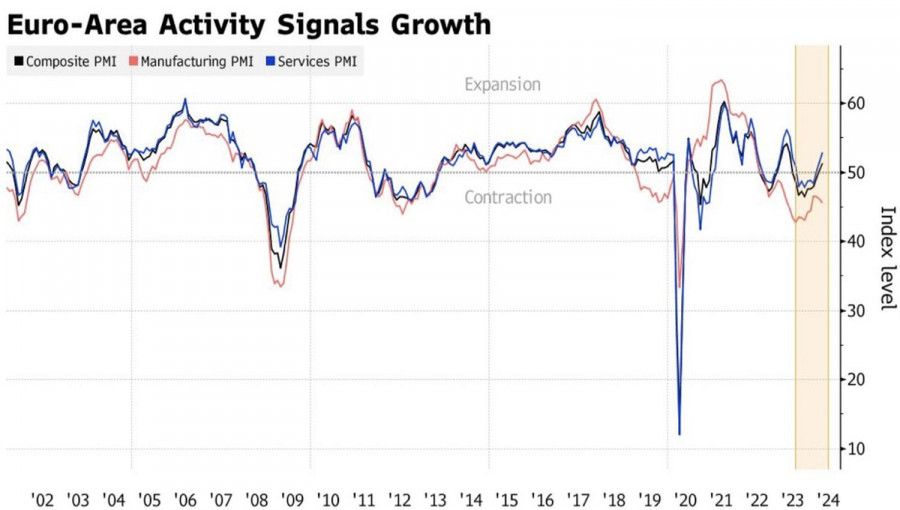The bulls attacked the EUR/USD pair after the eurozone Purchasing Managers' Index (PMI) data rose to nearly year-long highs. However, the pair failed to move significantly higher. The euro is too vulnerable, while its main opponent, the US dollar, is too strong.
The HCOB's preliminary composite eurozone PMI bounced to 51.4, which indicates that the European GDP expanded by 0.3% in the first quarter. This is higher than the Bloomberg analysts' forecast of +0.1%. Could it be that the dark period for the currency bloc is over?
The dynamics of business activity in the eurozone

Germany made a significant contribution to the PMI dynamics. Its business activity exceeded the key 50 mark for the first time since June, challenging Bloomberg experts who expected another unimpressive result. It's still too early to say that the German economy has regained its status as the locomotive of eurozone GDP growth, but positive shifts are always welcome for EUR/USD, especially considering that France continues to play the role of a workhorse.
A glimmer of light in the eurozone doesn't compare to the US. The US GDP is on track to expand by 2.5% in the first quarter, according to Bloomberg forecasts. It's no wonder that the US securities market is so enticing to foreign investors, which is one of the reasons why the dollar strengthened.
What drives the EUR/USD bears, greed or fear? The dollar's rise amidst the escalating geopolitical conflict in the Middle East suggested that it was benefiting from high demand for safe-haven assets. However, the Japanese yen and the Swiss franc are also considered reliable assets in Forex, yet they are somehow among the outsiders. At the same time, income currencies like the Mexican peso or the Canadian dollar incur lesser losses.
It's clear that the dollar's advantage comes from the high yield of bonds denominated in it and its appeal in general. This can be understood by looking at the interest rates in G10 currency issuer countries.
Interest rates in G10 currency issuer countries

When the economy is strong and global risk appetite is high, the US dollar becomes a profitable carry-trade asset. In contrast, the yen and franc's statuses as funding currencies leave them at the bottom of the race.

The eurozone economy may be improving, but if the US GDP does not cool down, the bulls cannot expect success. The main currency pair is stuck in consolidation within the range of 1.061-1.071, awaiting the release of US GDP data. Only this data can challenge the theory of American exceptionalism.
Technically, on the daily chart, the bulls attempt to return to the fair value range of 1.066-1.94. If bulls fail to keep the pair's quotes above the level of 1.066, this would provide grounds for selling.
The material has been provided by InstaForex Company - www.instaforex.comfrom Forex analysis review https://ift.tt/kYUaVD0
via IFTTT
